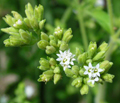 The proofs that stevioside has anti-inflammatory action of both invivo, as well as in vitro. It has been shown that the development of local skin inflammation inhibited steviol glycosides, including stevioside (Yasukawa et al., 2002).
The proofs that stevioside has anti-inflammatory action of both invivo, as well as in vitro. It has been shown that the development of local skin inflammation inhibited steviol glycosides, including stevioside (Yasukawa et al., 2002).
Stevioside and steviol showed anti-inflammatory effect on epithelial cells of the colon. Under physiological conditions colonocytes regulation functioning, not only forming a barrier, through which the transport of fluids and electrolytes, but also as a natural immune barrier to microbial pathogens (Sartor, 2008).
Colonocytes role in inflammatory reactions is primarily based on the specific interaction of receptors with antigens mikrooorganizmov-pathogens. This interaction leads to the subsequent induction of the synthesis of pro-inflammatory cytokines.
In assessing the impact of stevioside and steviol on the release of IL-8 from cell culture transplanted human colon it was found that the non-toxic dose of stevioside (<2 mM) and steviol (<0.2 mM) did not affect the induced TNF-? the release of IL-8, but it oppressed steviol (Boonkaewwan et al., 2008).

It was found that at a dose of 1 mM stevioside moderately increases the release of proinflammatory cytokines (TNF-? And IL-1?) And nitrogen oxides from human monocytes (Boonkaewwan et al., 2006).
Stevioside proven immunomodulatory properties in vivo (Sehar et al., 2008). When it is fed to mice at a dose of 6.25, 12.5 and 25 mg / kg of body weight increase was observed phagocytic index and stimulation of the humoral immune response, it was confirmed by the increase in titer of antibody against the test antigen. The experiments in vitro have also confirmed the ability stevioside increase the phagocytic activity and enhance the proliferation of B and T cells induced by concavalin A.
Furthermore, in mice stevioside retards the growth of skin tumors (Nakamura et al., 1995). It is shown that isosteviol inhibits DNA polymerase and DNA topoisomerase II human - cellular targets in the pharmacotherapy of cancer and inflammatory diseases (Mizushina et al., 2005). Moreover isosteviol slows the growth of three different types of human cancer cells.
It has been proven bactericidal action of stevia extract a wide range of pathogenic bacteria transmitted from contaminated food, enterohaemorrhagic Escherichia coli, capable, is known to cause hemorrhagic / exudative diarrhea (Tomita et al., 1997). Stevia extract also inhibited multiplication of rotavirus gastroenteritis in children causing blocking viral attachment to the cell wall (Takahashi et al., 2001). Was isolated from a plant polysaccharide with a molecular weight of 9,800 daltons that has for an antiviral effect. It is proved that such protivorotavirusnym have influence other factions stevia extract.
The results of a number of studies have confirmed that the culture medium containing Stevia slows the growth of Streptococcus mutans, Pseudomonas aeruginosa, Proteus vulgaris, and others. (V. Yodyingyuand et al., 1977), and vitamins and minerals that make up the stevia leaves are necessary for normal functioning of the immune system. Therefore, for the prevention of colds and flu are recommended to use the tea from the leaves of stevia.
The bactericidal properties of stevia are also manifested in the healing of wounds. If the shallow wound anoint concentrate stevia, it heals without scarring.
Ability of steviolovyh glycosides to inhibit the growth of bacteria (Streptococcus sorbinus) in the oral cavity, thereby steviosides can be used as additives to toothpastes in the treatment of caries. It was found that the use of products in which the sucrose is replaced by stevioside reduced susceptibility dental caries (Aguiar et al., 1987).
